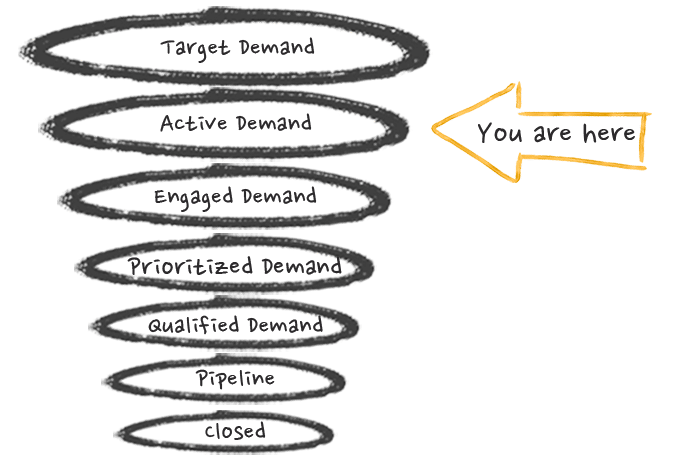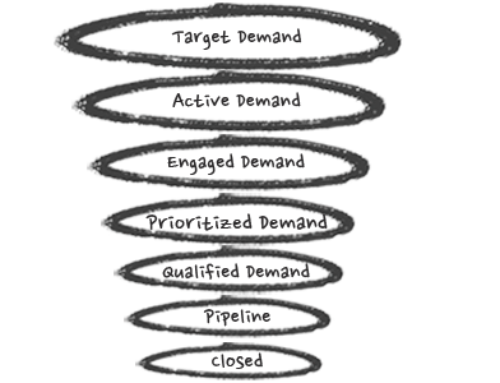
The principal objective in this Active Demand stage is to attract, identify and nurture in-market accounts until you have determined that they are interested in the kind of products or services that your company sells. If you are running or planning to run demand generation or awareness campaigns, this is the stage you would be doing that in.
Stumbling blocks
Determining who is in-market. There are tools and techniques you can use to determine whether an account is in-market. The ones that work best will depend on the nature of your prospects.
Knowing how long to nurture accounts in this Active Demand stage. There are no hard-and-fast rules about what constitutes enough interaction with an account to determine whether they should continue to be nurtured at this stage or moved to the next.
Preparing for success
The most common ways to determine whether an account is in-market are:
SEM. if there are keywords or key phrases that would indicate a buying signal and you’re getting clicks and/or form completions on those.
SEO. Visits or downloads of content that would generally be consumed when a prospect is actively in-market.
Events. Prospects that attend your events or come to your exhibit at a show and indicate that they are in-market for your type solution
Intent monitoring. The explosion of, and integration between, tracking technologies and data sources has led to the emergence of intent monitoring tools. Intent monitoring generally works by looking at the subject matter of the content that a company is consuming and then running statistical analysis against historical interest from that company in that subject. They evaluate the peaks and valleys of that interest and score the account for the interest in that subject.
For example, if a company started consuming a lot of content about point-of-sale systems, a point-of-sale vendor would conclude that the company is actively in-market for a new point-of-sale solution. The intent monitoring vendor generally provides this information as an account score based on the level of activity above a baseline for that account against that area of interest (in this example, point-of-sale systems). You may want to purchase companies that are showing a large spike of activity on the assumption that the company is about to make a purchase decision or you might want to purchase companies earlier in their journey that are showing moderate interest so you can place them in nurturing campaigns.
Note my language here: you only know that a company is shopping a solution, you don’t know precisely who or where inside that company.
I have used the intent monitoring tool from True Influence (full-disclosure: I have done consulting work for them in the past). They were able to give me names of accounts that were surging against the categories I had identified as relevant for my company’s service.
Since many accounts that you will be interacting within this Active Demand stage are still early in their evaluation process, offering form fills at this point may be premature, but you’ll want to test that regardless.

How Intent Marketing works (simplified).
- Employees read or download information related to a topic
- Using reverse IP-lookup, the company they are working at is identified
- Publishers open their websites to bots that classify all the content on their websites
- The behavior from each company is aggregated with their consumption of information on each topic
- The intent monitoring vendors track this behavior to evaluate the company behavior about each topic over time and identify when consumption rises above a baseline for consumption on that topic.
Beyond just tracking to determine which accounts are in-market you will also need to create campaigns designed to attract and nurture in-market prospects.
There are many good options for running ads against your target market to get the first click indicating interest and awareness. The key here is tight audience targeting. For example, if there are professional publications for your target market, paying for a sponsorship where you are running ads, sponsoring email newsletters or running webinars on their subscription base would be excellent options.
AdWords display. I have not found much success running outbound advertising on AdWords because the types of targeting parameters needed for B2B aren’t generally available. I would still encourage you to see if you can find your target audience on AdWords; I personally have had no luck with it (retargeting is a completely different story, which I will get into in more detail in the Engaged Demand post.)
Twitter ads can be a good option if you have collected the Twitter handles of the most read thought-leaders in your target market. You can then target the followers of those thought leaders with ads. Watch your cost per click as Twitter can often be pretty costly relative to return.
Facebook is a surprisingly effective channel for B2B because of the sheer number of targeting parameters you have available to you. Facebook has the richest set of audience targeting parameters out there. You will be pleasantly surprised to find that if you plug in topics, job titles, technologies and so forth into the Facebook audience targeting system, it will often return a result such as, “there are 1,200 people with this interest.” I was once challenged to create an audience from a very specialized area of scientific interest and was able to drive 14,000 conversions primarily with Facebook by focusing on unique terminology and job titles to that market.
Facebook also allows for audience lookalikes, where you can target audiences similar to the audience that is coming to your website, or a specific set of pages therein. I have had mixed results with this, but it is worth a test as I have heard from many colleagues that it has worked well for them.
LinkedIn has been getting better over time and now has a rich set of business and persona targeting parameters available for its ad programs. The challenge with LinkedIn is that there isn’t a lot of traffic volume, so unless your target is broad, you are not going to get much action. It is a platform that you want to run 24/7/365 though to catch the clicks you can. While costs per click on this network look ridiculously high compared to the others, I have almost always found that the quality of the visitors from LinkedIn more than makes up for the difference.
What to do once the account is showing interest
Your focus in this Active Demand stage of the Waterfall is driving awareness, building demand and urgency. Once that crosses the threshold to genuine interest, move the account down the Waterfall to the Engaged Demand stage. But what is genuine interest? Unfortunately, you will only know through testing.
My bias is to start by being aggressive about pushing the account down the Waterfall to the Engaged Demand stage. Start with a split test of single click/interaction vs. multiple clicks/interactions and then slowly increase the hurdle to reduce the percentage of accounts that stall in the next stage, until you have the ROI from this Active Demand stage optimized. Reference my account progression logic.
Once you get the first interaction from an account, you’re going to want to nurture them to gain more interaction. To amplify visitors to your website and to bring your overall cost per click down, you want to utilize retargeting. Install tracking scripts on your web properties for all the major networks, especially AdWords, Facebook, Twitter, and Linkedin so you can run retargeted ads to those visitors. You will need to set up advertising accounts in each of those networks to get the retargeting script, but you don’t need to start advertising immediately in order to get it set up.See more details on retargeting in the Engaged Demand post.
Side note: an additional benefit of putting these tracking scripts on your websites is that each network shows your audience data, and different networks can provide some unique data. This can be helpful for understanding who is coming to your websites and establishing whether it is attracting the wrong crowd.
Account-based advertising
Account-based advertising is a new class of advertising tools that give you the ability to target ads to a company, with further filtering on departments, job functions, and seniority level. Once these systems are implemented, you can apply automated processes that progress accounts through different campaigns accounts along the Demand Unit Waterfall. This process is automated and controlled through integration with your marketing and sales automation systems.

With account-based advertising:
With account-based advertising:
- Companies are identified through reverse-IP lookup databases so that all website traffic coming from employees working from the company offices will be associated with that company
- Employee information is collected, classified into department and seniority and anonymized.
- Firmographic data is added to the company database to provide for company size, employees, industry and other types of firmographic targeting.
- Marketers identify companies, departments and job seniority (c-level, vp-level, director-level, etc.) they want to build campaigns around their sales and marketing automation platforms and then run ads through the account-based advertising system.
- Ad campaigns are run to those company/department/seniority targets.
I have used the Terminus system which ties into sales force automation systems and can move accounts through campaigns along the buyer’s journey based on a wide range of criteria you can customize. Regardless of how you learn an account is in-market, account-based advertising gives you the ability to push ads to only those groups in those accounts that are likely part of the Demand Unit. It is an incredibly powerful technology and something that B2B marketers could only have fantasized about just a few years ago. Utilize what you understand about your customer profile and buying process to create a buyer’s journey. This will help you understand what collateral must be produced at all stages of the Demand Unit Waterfall and what you need to create in this Active Demand stage.
Utilize what you understand about your customer profile and buying process to create a buyer’s journey. This will help you understand what collateral must be produced at all stages of the Demand Unit Waterfall and what you need to create in this Active Demand stage.
Team makeup
Getting the most success from this Active Demand stage in the Waterfall requires interaction with the product team who should be able to provide market, needs, and persona analysis, along with a pretty good idea of how prospective customers research your-type of products or services. You can use those analyses to not only produce content but also to inform the language and messaging for your ads and collateral.
In most companies, you will also find salespeople who deeply understand the customer base. They are a font of knowledge about how prospective customers think, the language they use, what their needs are and the variations on the buying process that prospects use for evaluating your products. All of that is invaluable input for producing compelling marketing messaging and collateral.
Deliverables
Accounts that are sufficiently interested in your product or service that they would consider buying them.
A note on measuring the level of account engagement: At the time of this writing the concept of account scoring (vs. lead scoring) is still relatively new, and I’m not aware of any marketing or sales automation tools that do account-based scoring off-the-shelf. There are specialized account scoring tools like Engagio, a product that I have used and thought was compelling.
Account scoring in-depth
Much more detail on account storing here.
Typical materials that need to get produced in this Active Demand stage include:
- Messaging and landing pages customized to the different interests of the members of the Demand Unit
- Keywords and key phrases for SEM
- Awareness content for SEO
- Product & service overview website pages
- Display ads for retargeting
- Trade show booth
- Explainer videos
Measuring success for Active Demand
The principal KPI in this Active Demand stage is the number of accounts that are showing a sufficient level of interest that indicates that they are actively in-market and ready for further engagement.
Tracking metrics you will want to measure to help optimize for this outcome include:
- Digital marketing metrics: CPM, CPC, CTR
- Engagement metrics: account scores
- Website metrics: users, sessions, repeat visits, cohorts
- The cost per account required to move to the next, Engaged Demand stage



